Biskra
Biskra (Arabic: بسكرة ; Tibeskert; Latin Vescera) is the capital city of Biskra Province, Algeria. In 2007, its population was recorded as 307,987. Biskra is located in northeastern Algeria, about 248 miles (400 km) from Algiers, 71 miles (115 km) southwest of Batna and 137 miles (222 km) north of Touggourt. It is nicknamed "The Queen of the Zibans", "The Door of the Desert" or "The Saharan Nice" because of its location at the beginning of the Sahara Desert. Due to its geographical location, its climate and natural resources, particularly farming, Biskra has always been a hub and a crossroad between the cities in the north and south. It has seen the passage of several civilizations, from the Romans and the Arabs to the French.
Biskra
بسكرة | |
|---|---|
City | |
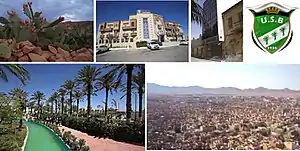 From left to right, and from top to bottom: A fig cactus from Mexico, Sidi Yahia Hotel (4 stars), A CNEP bank, The USB foot club, the Ziban garden park aqua, The Zabs mountains which surround the city. | |
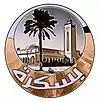 | |
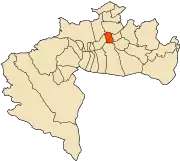 | |
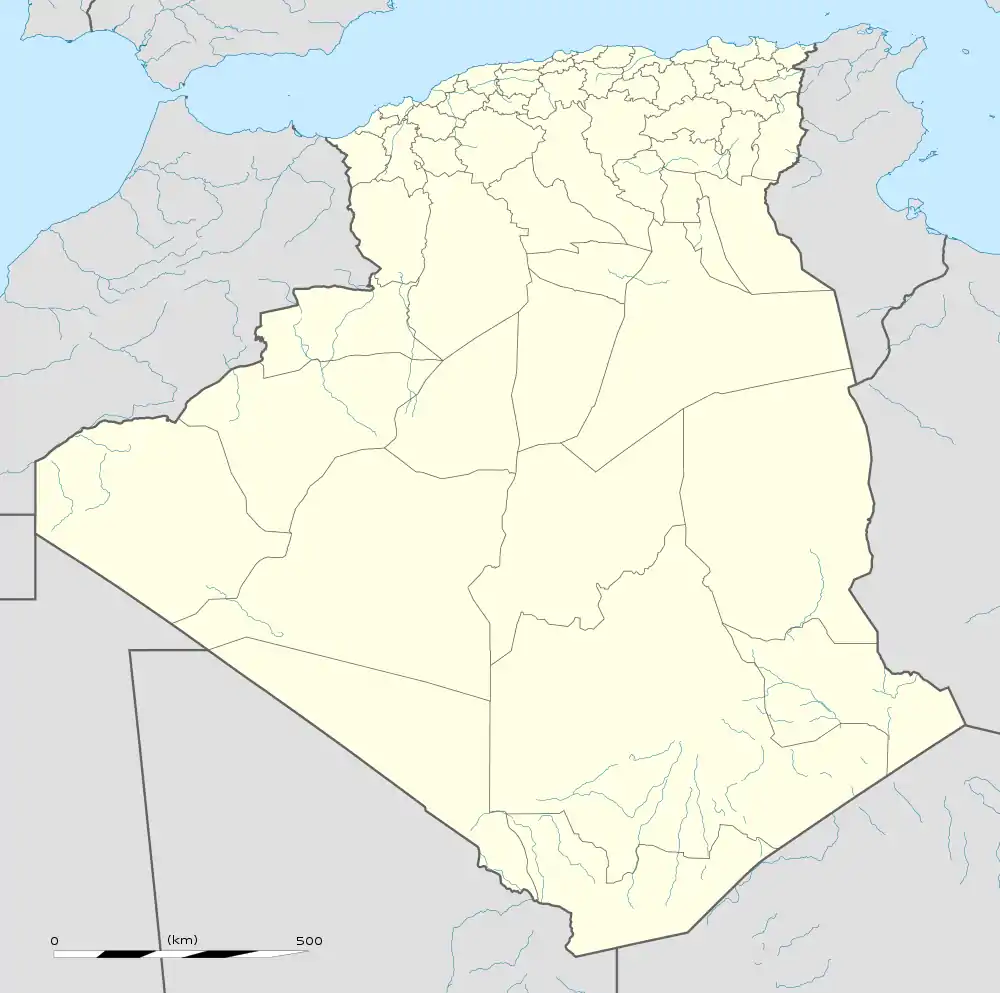 Biskra Location in Algeria | |
| Coordinates: 34°51′N 5°44′E | |
| Country | |
| Province | Biskra Province |
| District | Biskra District |
| Government | |
| Area | |
| • Total | 127.55 km2 (49.25 sq mi) |
| Elevation | 87 m (285 ft) |
| Population (2007) | |
| • Total | 307,987 |
| Time zone | UTC+1 (CET) |
| Postal code | 07000 |
| Climate | BWh |
| Major Airport | Biskra Airport |
| Website | |
In 1844, Biskra became a French garrison,[1] which saw fighting during rebellions in 1849 and 1871.[2]
Currently the city of Biskra has 28 neighborhoods, including the three principal neighborhoods of, Korra, City 60 Logements, and Equipment Zones. It is in the southern part of the Algerian rail system, and a popular winter resort.
Etymology
The city has been known by several names, including Biskra, Sokkra, Vescra, Vecera, Vescera, Adbesran. Historians do not agree on the origins of the current name. Some say its name comes down from the name Vescera, which means "station" or "place" of commercial exchange, due to its geographical location that connects north to south. But the Roman leader Betolimih BenyoubaII gave it another name, "the river of destiny", which is due to the river of Sidi Zarzour (its current name) that crosses the city.
Some researchers say that its name originates from the ancient Roman name "Adebesran," due to the ancient geothermal source that is located near the city, known as Salhine Hammam. Other sources say that the real name comes down from the word "Sokkra", due to the better quality of the sweet dates that this city has everywhere in its oases. Still others claim that the current name was given to the city by the Carthaginians.
History
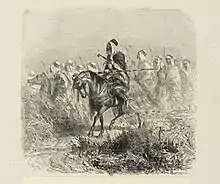
Gaetuli
The Gaetuli first appeared in North Africa during the 3rd millennium BC. They settled on a large territory south of the Roman provinces of Africa and Mauritania. The Genset, a direct descendant of the branch of the Capesian civilization that migrated to the Sahara around 3000 BC, and is certainly the people who dominated in the most certain way Algeria during the 1500 years of its antiquity. They were according to the Greek historian Strabo the most numerous people of North Africa, but also the least known. Among the oldest references to the Gétules are probably those of the Carthaginians who indicate that the Prince of the Gétules proposed to marry Élyssa (or Dido for the Romans), the founding queen of Carthage (present Tunisia) around the year 815 BC. However, references in ancient Egypt of certain tribes go back to 1350 BC about in the reign of Akhenaton of the eighteenth dynasty that speaks of cattle trade with this people.
The Gétules are probably also the origin of the Berber calendar which begins around 943–949 BC. The beginning of this calendar would follow the victory of a coalition of Gétules over the Egyptians. This coalition, formed by the North African tribes, left the south-west of Algeria, reinforcing its force en route wherever it passed in North Africa. The coalition led by Sheshonq (Berber name: Sheshnaq) defeated Pharaoh Psousennes II. Following this victory Sheshnaq married the daughter of the pharaoh, settled on the throne of Egypt under the name of Sheshonq in 952 BC, and founded the XXII Dynasty. This biblical event is mentioned in the Old Testament, which speaks of the pillaging of this leader of the Machaouach tribe. (The Berber calendar is a creation of Ammar NEGADI, it is he who chose this date for origin, his calendar was published in 1980 through the Association Union du Peuple Amazigh -UPA).
The Gétules are the Berber nomads of the pre-Saharan of North Africa and speak the Berber language with some variations. They came from the desert of the Caspian Sea (the world's largest inland sea, bordering present-day Iran) and were forced to migrate following the destruction of a natural dam that left them without a water source for their livestock. Specialists of the desert life, they first settled on the edge of the Nile. However, the Pharaohs hunted them in the sixth century BC.
Always while traversing the desert, arrived until Tassili with the Touaregs where they stayed a long time, got mixed up with the Touaregs and learned the Tamazigh language for reasons of communication, cultural and commercial exchanges. Unfortunately felt like "Gringos" in these places, decided to continue path until "The Promised Land":
North Africa which has become almost theirs. In Algeria, they have set themselves at the limit of Aures for the dish to which they are accustomed, have posed problems to the Roman infiltration in the 3rd century BC because dreaded in combat and good horsemen. It was necessary to involve a late Roman politician, Marius, to negotiate exploration of the South against concessions of agricultural land around Cirta and Setifis, at the time under Roman rule; a trick of dispersing them and so diminished in their strength. Thus, the Gétulie was occupied by the Romans (Biskra and its environs). This is what I learned from Charles Andrés Julien and Courteau, both history teachers at the Sorbonne and specialists in North Africa.
Roman Colonization
The city of Biskra experienced many very violent wars during the Roman colonization, including the great resistance war led by the Berber leader Tacfarinas. Followed by his successor the great healed militant Jugurtha "Youghorta" who resisted the Roman army. With the help of the inhabitants of the city, who did not hesitate to give their human and material support, Jugurtha destroyed the Roman army at the end of the so-called Noumidia region.
The Vandals in the 4th century
The Vandals "Oundals" invaded the city of Biskra and occupied all its land after a language resistance of its inhabitants. The weakness of the Vandals and lure falls in front of the resistance and the continuous fights of the inhabitants, forced them to integrate with the inhabitants of the Ziban in a complete way. After a few decades, the Romans took over the direction of the city where they built obstacles to protect themselves from the vengeance of the population.
The arrival of the Arab conqueror Uqba ibn Nafi al-Fihri in the 7th century AD
They remained with such vigilance until the arrival of the Arab conqueror Uqba ibn Nafi al-Fihri in the 7th century AD. During this period, the whole area came under another monarchy. it was the Arab-Muslim monarchy. After 20 years of conquest, Uqba ibn Nafi died in 683 AD with his army when he returned from Morocco. His death was organized by an ambush mounted by his adversary the Numidian prince (Berber) Koceila and his army at the place called Tahouda, a small village located 5 km from the oasis "Sidi Okba" whose body of this conqueror is based in the mosque of the city that took his name. According to the imam of this mosque, this place which contains more than 300 tombs, is the 4th holy place of Islam, after Mecca, Medina and Aksa.
In the early 10th century, Biskra and the entire Ziban area were conquered by the kings of Beni Hammad.
The Hillal Bannis in the 12th century AD
Followed by the Kabyla of Elathbend banished Hilal (Hilalian Arabs) who removed and confiscated the property of the inhabitants. They asked the help of the Almohads of the kingdom of Marrakech in the 12th century AD.
The Hafsids in the 14th century AD
In the 14th century AD, the Hafssid arrived in Tunisia and Algeria. Biskra became a very important pole for the Hafsids of Tunisia where it remained under lure monarchy and direction for a long time then under the authority of Mérinides of Fez and banned Abd-Elouadi and the Znatiyin of Tlemcen.
The conquest of the city by the Turks in 1541
In 1541, the conquest of the city by the Turks began, under the direction of Hocine Agha who defended the city of Algiers at the time and brought out the strength of Charles Compte of the latter.
The Ottoman Empire remained in the city 3 centuries until the French colonization in 1830.
French colonization from 1844
After the French conquest of Biskra in 1844, the site was fortified to secure the area against uprisings. El-hadj Mohammed Esaghire Elokbi, as the successor to El-Emir Abdelkader waged continued war against the French, attacking the French forces under Lamoriciere on 23 December 1847. Elokbi also opposed the Ben Ghana clan as well as Ahmed Bey's claim as ruler of Constantine. Resistance continued in the Ziban and Aurès Mountains.
In Biskra the local chief Bou Zian rallied the people against the palm tax, seizing the moated fortification of Zaatcha 20 km from Biskra. The French marched on Zaatcha, laying siege for months. It finally fell after 53 days of attacks by a French force of 7,000 troops. Bou Zian was killed. The French counted the loss of 2130. French control nonetheless remained tenuous when atacks were mounted again in 1879 at El-kamri.
Some 100 years after the battle of Zaatcha, in 1954 Biskra was again the scene of anti-French assaults during the Algerian War of Independence where house-to-house battles costed many lives.
In culture
At the end of the 19th century Biskra, a popular spa town and gateway to the Sahara, became a center for artists and photographers such as Émile Frechon, Alexandre Bougault and Rudolf Lehnert. From 1872 to 1920 the French Count Albert Landon de Longueville hosted in his villa-cum-chateau at Biskra (today Villa Bénévent), nobility, artists and writers, including Béla Bartok, Oscar Wilde, Scott and Zelda Fitzgerald, André Gide, Nasreddine Dinet, Eugène Fromentin, Karl Marx, Anatole France, Francis James and Henri Matisse.
Biskra is the setting of key sections of André Gide's 1902 novel The Immoralist and lesser known 1897 prose-poem Les nourritures terrestres (The Fruits of the Earth), and he visited the town in 1895 (for a fortnight from 31 January) with Lord Alfred Douglas, following a meeting with Oscar Wilde in Blida and Algiers.
The French artist Henri Matisse has a work titled Blue Nude (Souvenir de Biskra) an oil painting finished in 1907.
The Hungarian composer Béla Bartók collected traditional music in Biskra in 1913.
The Polish composer Karol Szymanowski, who traveled to North Africa, seemed to have been quite impressed by Biskra. This trip probably aroused a genuine interest for the North African/ Arabic culture. He composed many pieces influenced by his experience there. He sent a post card from Biskra on 11 April 1914.
Diana Mayo, protagonist of Edith Maude Hull's popular 1919 novel The Sheik, starts her journey into the desert from Biskra, and in the identically-named 1921 silent movie The Sheik starring Rudolph Valentino in perhaps his most famous role.
Winston Churchill's cousin, sculptress and author Clare Sheridan held a salon in Biskra in the 1920s and 1930s.[3]
Geography
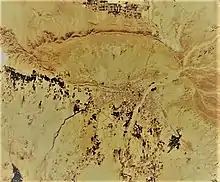
Biskra is located in the north-east of Algeria, in the district of Biskra. The city lies about 248 miles (400 km) from Algiers, 71 miles (115 km) southwest of Batna and 137 miles (222 km) north of Touggourt. She is nicknamed "The Queen of the Zibans", "The door of the desert" or "The Saharan Nice" because of its location which is the beginning of the desert. It is located at an altitude of 87 m (285 ft) in the northern part of the Sahara Desert.
Apart from the mountains that surround it, the topography of Biskra is generally very flat. Part of the city is surrounded by the Sfa Pass and the Ziban Mountains. In the outskirts of Biskra, the landscape is very arid with all the same vegetation that vary depending on the location. Small water points can be found in the outskirts of Biskra, especially in the oases and canyons of the mountains around El Kantara. The prefecture of Biskra is crossed by Oued Labiod waterways, Oued El Arab, Djedi, Oued Meziraâ, Oued El and Oued el Gantara. The city covers an area of 127.55 km2 (49.25 sq mi). It has a population of 307,987 and is the 10th most populous city. It has a population density of 1,612.0 inhabitants per square meter. The population of Biskra are called Biskri.
As in the rest of the country, Biskra does not observe summer time and stays in the same time zone all year round. Whether winter or summer, the time is always the same in Biskra. The sunrise is around 7:41 am to 21 December and 5:24 am on 21 June. The sunset is around 5:30 pm on 21 December and at 7:54 pm on 21 June.
Cityscape
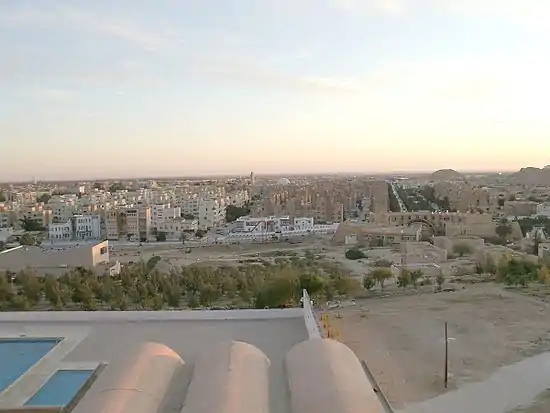

Neighborhoods
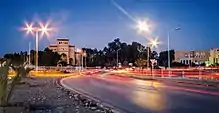


The city of Biskra has gone through three phases before getting to where she is today. Started by the pre-colonial phase which testifies, that the city was pending this period under Roman rule over country of the Berbers, and having taken the role of the capital of southern Numidia, and the
A very prosperous city, built by the Muslims in the Middle Ages. During the Turkish period the city was hit by epidemics, binding occupiers of the fort to leave the city to settle, in a group scattered the interior of the palm grove, south of the city, around two elements of the form local production, the built environment that are the mosque and seguias, besides the use local building materials.
Secondly, the city was marked by the colonial phase characterized by the building of fort Saint Germain on the northern part, and the construction of a city (the colonial checkerboard) by an urban model, different from the previous one, and having undergone several extension, particularly the 1st and 2nd and the Dervau Plan, followed during the 50s, by popular extensions to the South at the expense of the palm grove and without dimensional and formal logic.
In the end the post colonial phase characterized by the proliferation of self-built no plan to urban and architectural quality at least and without model, where typological reference, which has only to be curbed, after the instruction of the laws intervention and control of the state, over the urban space, by launching large Housing development operations in the framework of ZUNH, in the form of housing communal collective or subdivision which, despite this, has not been able to resolve the demand for housing, bringing the state to promulgation, other laws havingobjective, improving urban quality, openness and diversification stakeholders.
Today, the city of Biskra is made up of 28 neighborhoods including 3 main ones which are, Korra, City 60 Logts ENICAB and Equipment Zones.
Climate
Biskra has a subtropical hot desert climate (Köppen climate classification BWh) typical of the region in which it is found. The city has long and extremely hot summers and short, pleasantly warm winters. In summer, the peaks of heat are among the highest in the country with temperatures that can exceed 120 °F (48 °C) and are similar to cities like Luxor or Phoenix. The average peak July temperature, which is the hottest month, is about 108 °F (42 °C). On average, the city experiences more than 92 days a year where the temperature is equal to or exceeds 100 °F (38 °C) and nearly 20 days above 110 °F (37.8 °C). In comparison, New York City has had a total of 59 days when the temperature was equivalent to or above 100 °F (38 °C) since 1870. Temperatures generally begin to approach or even exceed 94 °F (35 °C) by April. Biskra is one of the hottest cities in the country when it comes to daytime temperatures. Indeed, this one is often higher than (27 °C) during the hottest months. The highest minimum temperature recorded in Biskra was 98.6 °F (37.5 °C) on 4 July 1993, making it the hottest night ever recorded in the city. On 14 July 1910, the temperature reached 124 °F (51 °C) which is the record of heat in Biskra.

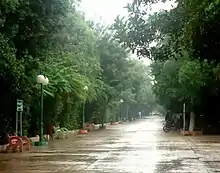
The climate is very dry and mostly very clear. Rainfall is limited to only 128.8 mm per year. Precipitation is quite rare despite some showers usually during the coldest months, mainly January and February, where it rains several times in the season, which brings the majority of humidity to Biskra in a year. The highest precipitation record recorded in Biskra in a year is (600.5 mm) in 1910 while the driest year is only (27.7 mm) recorded in 1945. The extreme heat that prevails during the summer can cause violent storms at the end of it and usually occur in September, when the air humidity becomes significantly higher with an average of 41% moisture per year. The month with the highest air rate in Biskra is December with 59% humidity, July is the least heavy month with only 27% on average per year. Aside from rainfall or humidity, sandstorms can occur several times a month and even become Haboob, which can make visibility almost zero. Biskra has a very good duration of sunshine in the year with an average of 3,292 hours of sunshine a year. The wettest month is November with (20.1 mm), while July is the driest month with (1.7 mm).
The hot, dry and sunny climate of the city sometimes attracts some inhabitants of the northern regions as in the city of Batna located 115 km northeast, which experiences fairly icy and wet winters during this period, to enjoy the pleasant weather and sunny in winter.
On average, Biskra knows no day in the year with a temperature below zero. Moving away from the urban area, the risk of frost may be more frequent and night temperatures are lower. Biskra very rarely experiences freezing days and only occurs occasionally during periods of mild cold weather. what can happen to Biskra and its surroundings. The record for the largest number of frost days recorded at Biskra in a winter is 1980–1981 with 73 days, while the record for the number of consecutive years experiencing freeze-up in Biskra is 1886 years. 1888. The lowest recorded temperature in Biskra was 23 °F (−5 °C) on 27 December 1914, while the lowest daily maximum temperature was 44.6 °F (7 °C) on 2 February 1934.
| Climate data for Biskra (1976–2005, extremes 1878–present) | |||||||||||||
|---|---|---|---|---|---|---|---|---|---|---|---|---|---|
| Month | Jan | Feb | Mar | Apr | May | Jun | Jul | Aug | Sep | Oct | Nov | Dec | Year |
| Record high °C (°F) | 26.0 (78.8) |
31.0 (87.8) |
34.8 (94.6) |
42.0 (107.6) |
45.3 (113.5) |
47.2 (117.0) |
51.0 (123.8) |
49.0 (120.2) |
46.0 (114.8) |
40.5 (104.9) |
35.3 (95.5) |
27.5 (81.5) |
51.0 (123.8) |
| Average high °C (°F) | 16.9 (62.4) |
19.2 (66.6) |
23.4 (74.1) |
26.1 (79.0) |
31.3 (88.3) |
37.6 (99.7) |
40.9 (105.6) |
40.4 (104.7) |
34.7 (94.5) |
28.2 (82.8) |
22.1 (71.8) |
18.5 (65.3) |
28.2 (82.8) |
| Daily mean °C (°F) | 11.5 (52.7) |
13.6 (56.5) |
17.6 (63.7) |
21.3 (70.3) |
25.8 (78.4) |
32.5 (90.5) |
34.5 (94.1) |
34.2 (93.6) |
30.0 (86.0) |
23.2 (73.8) |
16.8 (62.2) |
12.9 (55.2) |
22.8 (73.0) |
| Average low °C (°F) | 6.1 (43.0) |
7.9 (46.2) |
11.7 (53.1) |
16.5 (61.7) |
20.2 (68.4) |
26.6 (79.9) |
28.1 (82.6) |
27.9 (82.2) |
25.3 (77.5) |
18.1 (64.6) |
11.4 (52.5) |
7.2 (45.0) |
17.4 (63.3) |
| Record low °C (°F) | −3.0 (26.6) |
−0.5 (31.1) |
1.3 (34.3) |
3.0 (37.4) |
5.0 (41.0) |
12.0 (53.6) |
16.1 (61.0) |
15.0 (59.0) |
11.0 (51.8) |
4.2 (39.6) |
1.0 (33.8) |
−5.0 (23.0) |
−5.0 (23.0) |
| Average precipitation mm (inches) | 17.4 (0.69) |
10.2 (0.40) |
13.6 (0.54) |
13.1 (0.52) |
11.1 (0.44) |
5.1 (0.20) |
1.7 (0.07) |
5.7 (0.22) |
10.4 (0.41) |
11.3 (0.44) |
20.1 (0.79) |
9.1 (0.36) |
128.8 (5.07) |
| Average precipitation days (≥ 0.1 mm) | 3.7 | 3.2 | 3.5 | 3.3 | 2.8 | 2.3 | 0.6 | 1.6 | 3.2 | 3.8 | 3.8 | 3.7 | 35.5 |
| Average relative humidity (%) | 57 | 50 | 44 | 39 | 34 | 31 | 27 | 31 | 41 | 48 | 55 | 59 | 43 |
| Mean monthly sunshine hours | 223.2 | 223.2 | 260.4 | 282.0 | 319.3 | 333.0 | 362.7 | 328.6 | 270.0 | 266.6 | 213.0 | 210.8 | 3,292.8 |
| Mean daily sunshine hours | 7.2 | 7.9 | 8.4 | 9.4 | 10.3 | 11.1 | 11.7 | 10.6 | 9.0 | 8.6 | 7.1 | 6.8 | 9.0 |
| Source 1: World Meteorological Organization (average temperatures, Climate of Algeria) (precipitation, 1976–2005),[4] NOAA (mean temperatures, 1965–1990),[5] | |||||||||||||
| Source 2: Arab Meteorology Book (humidity and sun),[6] Meteo Climat (record highs and lows)[7] | |||||||||||||
Flora and Fauna
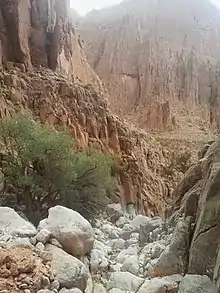

The fauna of Biskra is characterized by a great diversity of insects such as Sacred Scarab and yellow broad-tailed scorpions are found. There are also amphibians like frog, reptiles like the Horned Viper or the Egyptian cobra. A variety of birds including Black Warbler, mammals such as Gazelles, small Gerboise, Fox, Wild boar, Hare, Hedgehog, Bat, Myriapods, Crustaceans such as the Crab stream or the Water Flea. There are also a lot of black and red spiders that some species hide in dead tree stumps.
Demographics
Population
| Year | Population[8] |
|---|---|
| 1901 | 7,500 |
| 1911 | 20,000 |
| 1926 | 22,000 |
| 1931 | 18,900 |
| 1936 | 21,300 |
| 1948 | 36,400 |
| 1954 | 52,500 |
| 1966 | 59,300 |
| 1977 | 77,000 (town) 90,500 (municipality) |
| 1987 | 128,300 |
| 1998 | 177,600 |
| 2010 | 300,000 |
References
- "Market, Biskra, Algeria". World Digital Library. 1899. Retrieved 25 September 2013.
- The Modern world encyclopedia : illustrated. Home Entertainment Library. 1935. OCLC 1091880941.
- "A Modest Proposal". Time. 24 March 1941. Retrieved 19 April 2011.
... In Biskra he frequented the Algerian salon of Winston Churchill's cousin, sculptress Clare Sheridan (Arab Interlude). ...
- "World Weather Information Service–Biskra". World Meteorological Organization. Retrieved 17 October 2016.
- "Climate Normals for Biskra". Retrieved 11 February 2013.
- "Appendix I: Meteorological Data" (PDF). Springer. Retrieved 17 October 2016.
- "Station Biskra" (in French). Meteo Climat. Retrieved 17 October 2016.
- "ALGERIA: urban population". www.populstat.info. Archived from the original on 3 March 2016.
External links
![]() Media related to Biskra at Wikimedia Commons
Media related to Biskra at Wikimedia Commons
| Wikisource has the text of the 1911 Encyclopædia Britannica article Biskra. |
- (in French) Biskra City
.svg.png.webp)